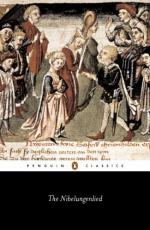|
This section contains 6,462 words (approx. 22 pages at 300 words per page) |

|
SOURCE: “The Reconciliation in the Nibelungenlied,” German Life and Letters, Vol. XXX, No. 2, January, 1997, pp. 138-49.
In the following essay, McLintock explains that the Nibelungenlied is best approached aesthetically, for its literary qualities.
Recent years have seen numerous interpretations of the Nibelungenlied. Scholars have sought to elicit its ‘meaning’ or ‘message’ and imagined they could divine the author's ‘intention’: he was contrasting ‘pagan’ and ‘Christian’ values, deploring revenge, finding fault with old-style ‘demonic’ heroism, or demonstrating the baleful effects of lay arrogance. Some of these readings, one suspects, would have been incomprehensible to the poet and his audience; others perhaps capture attitudes that they would have shared. Most tend to reduce the work to an exemplum; the epic, however, refuses to be compassed by neat interpretative schemes.1 The poet was an artist, not a thinker, and if we wish to appreciate his poem we must approach it aesthetically...
|
This section contains 6,462 words (approx. 22 pages at 300 words per page) |

|


